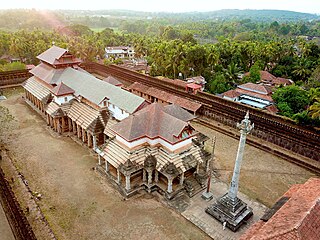
Shravanabelagola is a town located near Channarayapatna of Hassan district in the Indian state of Karnataka and is 144 km (89 mi) from Bengaluru. The Gommateshwara Bahubali statue at Shravanabelagola is one of the most important tirthas in Jainism, one that reached a peak in architectural and sculptural activity under the patronage of Western Ganga dynasty of Talakad. Chandragupta Maurya is said to have died on the hill of Chandragiri, which is located in Shravanabelagola, in 298 BCE after he became a Jain monk and assumed an ascetic life style.

A Bhaṭṭāraka heads traditional Digambara Jain institutions. He is responsible for training scholars, maintenance of libraries, managing endowments, presiding over installation ceremonies and running Jain institutions.

Padmāvatī is the protective goddess or śāsana devī (शासनदेवी) of Pārśvanātha, the twenty-third Jain tīrthāṅkara, complimenting Parshwa yaksha in Swetambara and Dharanendra in digambar the shasan deva. She is a yakshini of Parshwanatha.

Venur or Venoor is a small village on the banks of the Phalguni river in Belthangady Taluk, Dakshina Kannada of Karnataka, India. It was once the seat of Jainism and the capital of the Ajila Dynasty. It is on the Dharmasthala-Moodabidri-Karkala route on the coastal religious circuit in the Karnataka State of India.

Moodubidire is a town and taluk in Dakshina Kannada district. It lies 34 km northeast of the district headquarters, Mangalore, in Karnataka, India.

Karnataka, a state in South India has a long association with Jainism, a religion which enjoyed patronage of major historic kingdoms in the state such as the Rastrakuta Dynasty, Western Ganga, Kadamba and Chalukya dynasties and the Hoysala Empire. Today the state is home to a number of Jain monuments, such as temples, Gommata statues and stambhas.

Balatkara Gana is an ancient Jain monastic order. It is a section of the Mula Sangh. It is often termed Balatkara Gana Sarasvati Gachchha. Until the beginning of the 20th century it was present in a number of places in India. However all its seats in North India became vacant in early 20th century. It survives only at Humbaj in Karnataka, which is its ancient seat.

Kalasa is a taluk located in Chikmagalur district in Karnataka. Kalasa is home to the Kalaseshwara Temple dedicated to Lord Shiva. Kalasa lies 92 Kilometres South-west of Chickmagalur and is located on the banks of the Bhadra River. Kannada language is spoken here.

Saavira Kambada Temple or Tribhuvana Tilaka Cūḍāmaṇi), is a basadi or Jain temple noted for its 1000 pillars in Moodabidri, Karnataka, India. The temple is also known as "Chandranatha Temple" since it honours the tirthankara Chandraprabha, whose eight-foot idol is worshipped in the shrine.

Jainism in North Karnataka flourished under the Chalukyas, Kadamba, Rashtrakutas, and Vijayanagara Empire. Imbued with religious feeling, patronage was extended towards the building of Jain temple and it garnered high repute among the people, particularly the ruling classes and the mercantile community; effectively getting treated as the state religion.

Karkala is a town and the headquarters of eponymous Karkala taluk in the Udupi district of Karnataka state in India. It lies near the foothills of the Western Ghats, Karkala has a number of natural and historical landmarks, and is a major tourist and transit destination due to its strategic location along the way to Hebri, Sringeri, Kalasa, Horanadu, Udupi, Kollur, Subrahmanya and Dharmasthala.

Guru Basadi is a basadi or Jain temple located in Moodabidri town in the Indian state of Karnataka. The Guru basadi is the oldest amongst 18 Jain basadis in Moodabidri built in 714 CE. This temple is near another Jain temple, Saavira Kambada Basadi.

Chaturmukha Basadi is a symmetrical Jain temple situated in Karkala, Karnataka, India. It is one of the most famous monuments in Karkala.

Kanakagiri Jain tirth kshetra also known as Kanakadri and Hemantha Desha is situated at about 3 km from Maleyuru, Chamarajanagar district, 53 km from the Mysore city and 182 km from Bengaluru.
Shri Atishaya Kshetra Simhanagadde Jwala Malini Digambar Jain Temple or Atishaya Shri Kshetra Simhanagadde is a famous Jain temple in Narasimharajapura of Chikmagalur district in Karnataka.

Santara or Bhairarasa was a medieval ruling dynasty of Karnataka, India. The area covered by their kingdom included territories in the Malenadu region as well as the coastal districts of Karnataka. Their kingdom had two capitals. Karkala in the coastal plains and Kalasa in the Western ghats. Hence the territory they ruled was also known as the Kalasa-Karkala kingdom. The Santaras were Jains and had matrimonial relations with the Saivite Alupa royal family. The Santaras became the feudatories of the Vijayanagara Empire after its rise. During this period, the Santara ruler Veera Pandya Bhairarasa erected the monolith of Bahubali in Karkala. The dynasty passed into oblivion after invasions by the Nayakas of Keladi and later by Hyder Ali.

Kere Basadi or Chaturmukha Basadi is a Jain temple located in Varanga village in Udupi district of Karnataka, India. This 12th-century temple is situated amidst of a lake giving it the name Kere Basadi. The temple is also known Chaturmukha Basadi as it houses a chaturmukha (four-faced) idol of tirthankaras. The temple is situated 26 km from Karkala, another popular Jain centre.

The Humcha Jain temples or Humcha basadis are a group of temples found in Humcha village of Shimoga district in Karnataka, India. They were constructed in the 7th century CE in the period of the Santara dynasty and are regarded as one of the major Jain centres of Karnataka. The Padmavati Basadi is the most well-known of these temples.

The Lakshmeshwara Jain temples is a group of Jain temples in the town of Lakshmeshwara in the Gadag district of Karnataka.

Gommateshwara statue, Karkala is located at Karkala in the Indian state of Karnataka. It is the second tallest statue of Bahubali in the world with the largest statue located at Shravanabelagola.





















